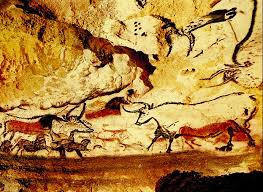Public Wall Art Unit: Cave Painting
- marleeyunger
- Nov 10, 2014
- 4 min read
Cycle Level: 2
Here's a looking into cave painting.
The Lesson
Introduction
Cave paintings are paintings found on cave walls and ceilings that date back to prehistoric times. The prehistoric people painted marvelous and astonishing paintings on rock walls and ceilings, deep within caves. They crawled on their bellies, through narrow, dark tunnels. The caves discovered have hundreds of different paintings, made by many different painters. The most common themes in the oldest cave painting were of large wild animals, such as the horse, bull, bison, mammoth, and deer. Many hunting scenes were depicted, a few people, and many handprints, (as a form of signature), and symbols. The animals were drawn very well, but the people were often stick people.
Prehistoric people painted with natural materials by mixing water, plant juice, blood, soil, charcoal, and mineral pigments found in the earth to produce mostly colors such as red, orange, or yellow, brown, and black came from charcoal. Brushes were made by putting together sticks, small stones, leaves, and animal hair.
Nobody really knows why the prehistoric people painted in these caves because the caves were often very isolated and not easily accessible. We can guess that it was a way for them to communicate with others, for religious purposes, to be sheltered form bad weather, or to show scenes of hunting expeditions. The earliest cave paintings found date back to approximately 17,000 years ago. These were found in Europe, although many other cave paintings were also found in Asia, America, India, and Africa among other countries. The most famous of these caves is in Lascaux, France. The Lascaux Cave was discovered accidentally in 1940 by some young children playing in the area. For many years people were allowed to visit the caves, but of course, this started to damage them. The cave was closed to the public in 1963, but we can will visit it today...virtually.
Go to : http://www.lascaux.culture.fr/#/en/00.xml/index.html To get the full effect, turn off all the lights in the room.
Development
Stimulus for Creation: A PowerPoint Presentation will be showed to introduce the topic and draw the students’ attention. In addition, the student will be able to explore the cave through a virtual tour of the Lascaux Caves that will be shown on the Smart Board. This way, the students can visualize what the caves look like without having to take a field trip to France. I will not be bringing any examples of art project to the class because I do not want to the student to be discourages if it looks like it is something that they do not think they can draw. Also, I want to encourage them to come up with their own animal that they would like to draw. If some students are having a difficult time I will help them brainstorm ideas of what to draw.
Learning Activities: In order for the students to success in this lesson, they must already know what tempera paint it (covered in Marlee’s lesson); they must know about cave paintings, which I will explain before the art project; and they must know how to identify different wild animals, as they will be asked to draw them. The visual arts concepts will be introduced through the PowerPoint Presentation and the virtual tour of the caves. The students will be showed pictures of animal drawings in the caves After the presentation and virtual tour, the teacher will quickly demonstrate to the class what it is exactly that the students will be doing. For instance, the teacher will take an already cut paper bag, crumple and flatten it, paint a something simple will not take very much time, and outline it with a black marker to define the shape.
Procedure: Step 1: Get a brown grocery bag and tear, not cut a sheet approximately 10” x 12”. This gives the paper a worn look. Step 2: Crumple the piece of paper bag tightly and then flatten it out. The wrinkled texture that results on the paper, gives it the appearance of a rough wall.
18
Step 3: Draw in pencil two or three prehistoric animal reviewed (horse, antelope, bison, mammoth, bear, deer, etc.) Along with a symbol or person. Step 4: Paint using only the colors given. You may mix and blend colors assigned to get a wider array of shades.
Step 5: Outline the animals in black to define their shape.
*Adaptation: For students with disabilities: group with another student to help choose and outline the animal.
Closure
Suggested follow-up questions that will help the teacher guide the students to a deeper understanding of the work as well as evaluate the students overall understanding of the lesson by presenting different students’ artwork and discussing them.
What is going on in this picture?
What animal do you see in this picture?
What can you tell me about the colors in this artwork?
What do you think is the meaning of the drawings?
What are some reasons that prehistoric people made cave drawings?
To tell stories, keep records, represent religious events, worship.
Why did ancient people choose caves for their art instead of other places?
To keep pictures secret, to shelter from bad weather, good surfaces for drawing, and religious reasons.
In what ways are cave drawings like television, magazines, or newspapers?
Pictures tell stories and record history.
Assessment
Did student paint a minimum of 2 prehistoric animals?
Did student give thought to the colors used?
Were the animals outlined in black?
Craftsmanship of the final drawing shows a conscious effort was made to be accurate, regardless of students artistic skill or ability; Was painting neat and complete?
Did student display positive response during the lesson (ask valid questions and participated)?
Did student us time efficiently (little chatting and stayed on the job)?






































Comments